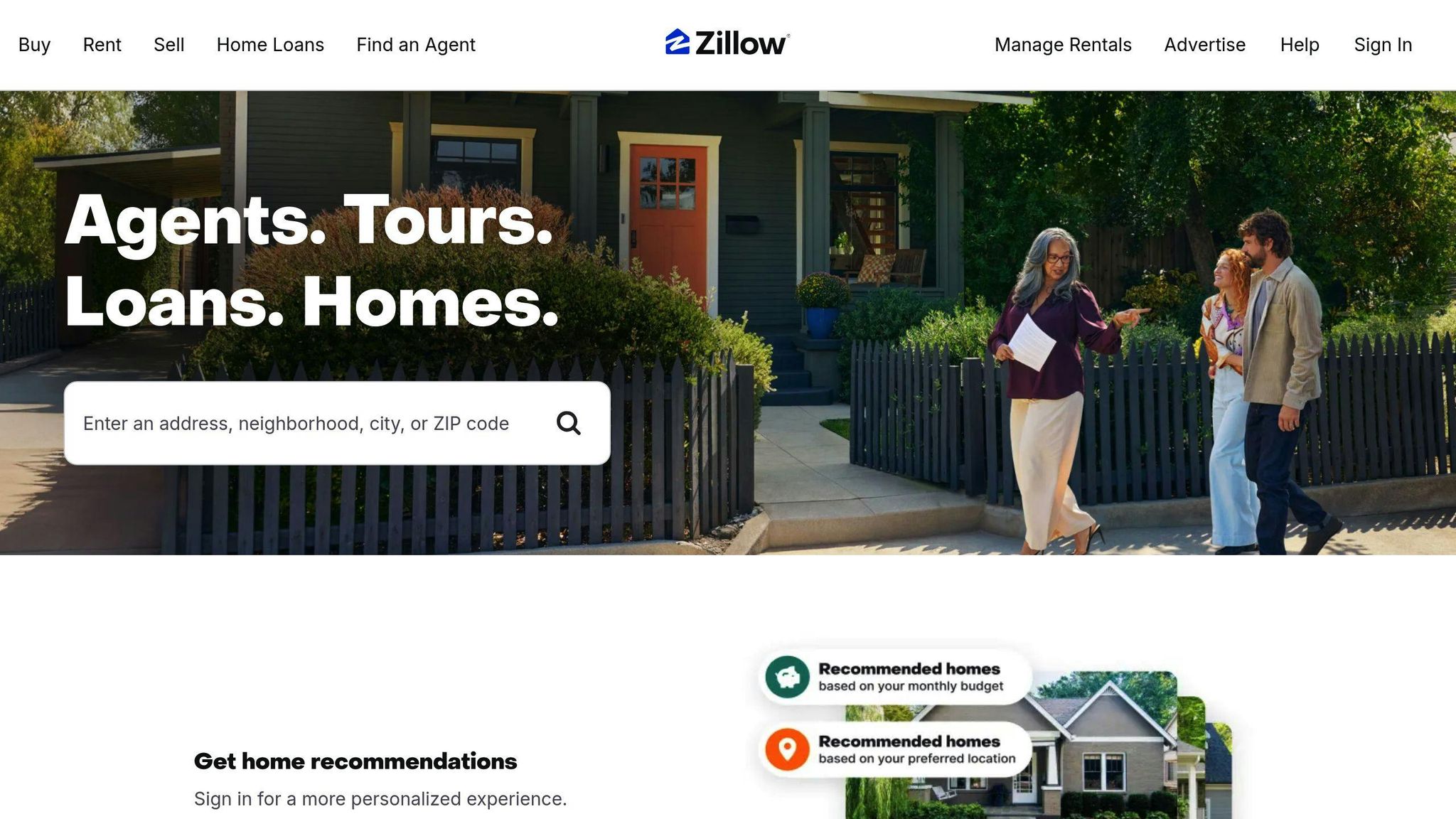AI virtual tour tools are transforming real estate in 2024. These tools use artificial intelligence to create immersive 3D property tours, saving time and offering better client experiences. They help agents showcase properties remotely, provide tailored tours based on client preferences, and simplify decision-making for buyers.
Key Benefits:
- Faster Creation: Generate 3D models and floor plans in under 24 hours.
- Customization: Adapt tours based on user behavior, like highlighting popular areas.
- Accessibility: Mobile-friendly and easy to share across platforms.
Top Tools:
| Tool | Features | Best For | Price Range |
|---|---|---|---|
| Dialzara | AI customization, 3D models | Luxury properties | Premium pricing |
| Epique | Interactive tours, sharing | Small teams, agents | Mid-range |
| CubiCasa | Quick creation, easy-to-use | New agents, high volume | Budget-friendly |
To get started, choose a tool that fits your needs, ensure compatibility with your devices, and focus on creating accessible, engaging tours for your audience.
Game-Changing AI for Virtual Tours
Features of AI Virtual Tour Tools
Automated 3D Models and Floor Plans
AI virtual tour tools have changed the game for real estate professionals by simplifying the creation of property layouts. These tools can produce detailed 3D models and floor plans in record time - often within 24 hours - saving significant effort and resources. Thanks to advanced algorithms, the process is both fast and precise.
"CubiCasa allows agents to create immersive tours effortlessly, making listings stand out."
| Feature | Benefit | Impact |
|---|---|---|
| Automated Generation | Cuts creation time to 24 hours | Reduces operational costs |
| High Accuracy | 99% measurement precision | Builds client confidence |
In addition to saving time, these tools provide tailored experiences that cater directly to client preferences.
Customizing Tours for Clients
AI tools analyze visitor behavior to create tours that feel more personal. They track:
- How long users spend on specific areas
- Which features grab the most attention
- Common navigation patterns
Using this data, the system adapts future tours to better match client interests. For instance, if kitchens consistently attract attention, the AI ensures kitchen views are prioritized in future tours. This level of customization helps keep potential buyers engaged and interested.
Interactive and Shareable Tours
Sharing and interacting with virtual tours has never been easier. Zumper's collaboration with Matterport highlights this: their shareable virtual tours led to 70% of renters making decisions without needing an in-person visit.
Interactive features include:
- Detailed utility information and property specs
- 360-degree visualizations of properties
- Simple sharing via websites and social media
- Tools for remote collaboration with global audiences
These capabilities make property marketing more engaging and convenient, streamlining the decision-making process for clients.
How to Use AI Virtual Tours Effectively
Selecting the Right AI Tools
Choose tools that simplify layout creation, allow for customization, and align with your technical skills.
| Selection Criteria | Key Points | Outcome |
|---|---|---|
| Business Requirements | 3D modeling, customization options | Better property presentation |
| Technical Expertise | Ease of use, training needs | Quicker setup |
| Integration Features | Compatibility, sharing capabilities | Smoother workflow |
Platforms like qbiq are a great example of AI-driven solutions. They offer tenant-specific customization and generate multiple layout options based on user preferences. This is especially useful for commercial real estate professionals, helping them engage clients and simplify decision-making.
Once you've chosen the right tools, pairing them with technologies like VR and AR can take client experiences to the next level.
Combining AI with VR and AR
Using AI alongside virtual and augmented reality creates a more engaging way for clients to explore properties. AI enhances VR tours by automatically adjusting lighting, colors, and adding informative labels, making the experience visually appealing and informative.
The National Association of REALTORS highlights that staying informed about these technologies is critical for staying competitive in the current market. This is particularly beneficial for remote buyers who can explore multiple layouts without needing to visit in person.
However, while these tools make viewing more immersive, ensuring they are accessible is crucial.
Making Tours Accessible to Everyone
AI tools can make virtual tours more inclusive by optimizing them for various devices and user needs. Here are some key areas to focus on:
- Mobile compatibility: Ensure tours work seamlessly on smartphones and tablets.
- Loading speed: Optimize for users with slower internet connections.
- User-friendly design: Create navigation that works for all age groups.
These efforts expand your reach, making it easier to connect with international clients or those with mobility challenges. AI-powered virtual tours also help reduce the time it takes for clients to make decisions, offering a more efficient and inclusive property-viewing experience.
sbb-itb-db182b0
Best AI Virtual Tour Tools for 2024
Overview of Popular Tools
Dialzara stands out with its AI-driven customization and detailed 3D models, making it a top choice for showcasing luxury properties and meeting the needs of large agencies. Epique provides affordable, interactive tours with straightforward sharing features, catering to individual agents and smaller teams. CubiCasa focuses on ease of use and affordability, making it a great fit for newer agents and those managing a high volume of listings.
"Real estate professionals are constantly looking for ways to make their listings stand out, and with CubiCasa Tour, they can now create beautiful, immersive tours effortlessly."
Comparison of Features and Costs
| Tool | Key Features | Price Range | Best For |
|---|---|---|---|
| Dialzara | AI customization, 3D models, multi-device support | Premium pricing | Large agencies, Luxury properties |
| Epique | Interactive tours, simple sharing | Mid-range | Individual agents, Small teams |
| CubiCasa Tour | Quick creation, simple interface | Budget-friendly | New agents, High-volume listings |
Using AI Tools for Real Estate Agents
For agents who find the range of options overwhelming, the AI Tools For Real Estate Agents directory is a helpful resource. It organizes tools into categories to make the selection process easier, with a focus on:
- Integration with current marketing platforms
- Customization for various property types
- Mobile-friendly design and sharing capabilities
- Training and support availability
As these tools continue to evolve, staying informed about new advancements and addressing challenges in adoption will be key for real estate professionals.
Trends and Challenges in AI Virtual Tours
New Trends in AI Virtual Tours
AI-driven tools like predictive analytics and customization are reshaping virtual tours. These technologies analyze market trends and buyer behavior, offering interactive 3D experiences that let clients better understand how spaces can be utilized . This combination of immersive visuals and data-backed insights is helping buyers make more informed decisions.
The virtual reality real estate market is on the rise, with Goldman Sachs estimating it could reach $2.6 billion by 2026. This growth highlights the increasing use of AI-powered virtual tours and their role in modern property marketing.
However, despite these advancements, adoption still comes with its fair share of challenges.
Barriers to Adoption
Real estate professionals encounter several hurdles when introducing AI virtual tour technologies:
| Challenge | Impact | Potential Solution |
|---|---|---|
| Technical Complexity | Difficulty merging AI with VR/AR | Opt for intuitive platforms with training support |
| High Costs | Expensive hardware and software | Explore cost-effective, smartphone-based tools |
| Resistance from Teams | Hesitation to embrace new tools | Demonstrate ROI using engagement and lead data |
| Integration Problems | Issues connecting with existing tools | Choose platforms designed for smooth integration |
Smaller agencies, in particular, struggle with the technical demands of combining AI and VR/AR. While newer platforms aim to simplify the process, many professionals still face steep learning curves.
The upfront costs for equipment, software, and training also remain a barrier. That said, tools designed for smartphones are making these technologies more accessible. Agencies that measure success through metrics like engagement and lead generation are finding it easier to justify these investments.
Overcoming these challenges is crucial for the real estate industry to fully embrace AI and unlock its potential in property marketing.
Conclusion and Next Steps
How AI is Changing Real Estate Marketing
AI-powered virtual tours are reshaping property marketing by automating processes and creating better buyer experiences. A standout example is CubiCasa, which allows agents to produce professional-quality tours with just smartphone scans and listing photos.
"Real estate professionals are constantly looking for ways to make their listings stand out, and with CubiCasa Tour, they can now create beautiful, immersive tours effortlessly."
These tools open up new opportunities for agents to seamlessly incorporate AI into their daily workflows.
Steps to Get Started
To make the most of AI virtual tour tools, follow this simple plan:
| Phase | Action Items | Expected Outcomes |
|---|---|---|
| Research | Explore available platforms | Identify tools that suit your goals and budget |
| Implementation | Use smartphone-based solutions | Quick setup with minimal effort |
| Integration & Review | Combine with existing strategies and monitor results | Improved efficiency and measurable ROI |
Start with platforms that are user-friendly and offer robust training resources. Websites like AI Tools For Real Estate Agents can help you find solutions tailored to your needs.
For best results:
- Make tours accessible across all devices
- Provide clear navigation instructions
- Offer multilingual options for global audiences
- Include alternative viewing formats for accessibility
Keep an eye on metrics like tour engagement and interaction times to measure success and make necessary adjustments. The key to thriving with AI virtual tours lies in using them to improve property viewing experiences and simplify transactions.
FAQs
Are Zillow 3D tours worth it?

Zillow 3D tours can be a budget-friendly option for real estate agents. They offer features like a 7-day boost in search rankings, an easy setup using just a smartphone, and are well-suited for occupied homes or more straightforward layouts. These tours make it easier to market properties while giving potential buyers a convenient way to view them remotely.
Here’s a quick breakdown of the benefits:
| Feature | Description |
|---|---|
| Search Visibility | Increases search rankings for 7 days |
| Budget-Friendly | Lower cost compared to tools like Matterport |
| Ease of Use | Simple process using a smartphone |
To get the most out of Zillow 3D tours:
- Ensure good lighting when capturing images.
- Cover every space in the property thoroughly.
- Include detailed descriptions for each area.
- Monitor engagement metrics to see what works.
These tours are a straightforward way for agents to step into AI-powered property marketing, offering practical tools that simplify the process for professionals at any level. They highlight how technology is reshaping real estate marketing by making advanced tools easier to use.


